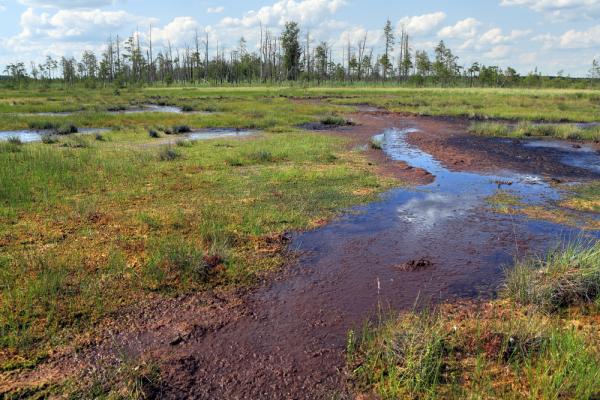Climate
The climate of the Polistovsky Reserve is moderately continental. It is formed under the influence of Atlantic, continental and Arctic air masses in conditions of increased cyclonicity. Average monthly air temperatures here are: in January - 8.1 ° C, in July - + 17.2 ° C. Annual precipitation, corrected by a rain gauge, is 685 mm. Calms on the territory of the reserve does not exceed 5 days per year, the rest of the time is accounted for windy days. In general western and south-eastern winds prevail insignificantly, northern, eastern and north-eastern winds are the most rare. Winds in winter are more often observed south and southwest, and in summer - west and southwest winds, the average speed of which is 2-6 m/s.
Repeatability of winds (%%)
|
North 7* |
East 7 |
South 14 |
West 19 |
|
Northeast 7 |
Southeast 18 |
Southwest 16 |
Northwest 12 |
*- The percentage of the number of windy days is indicated, the calm on the territory of the reserve is 5 days per year.
Seasonality
Winter (mid-November-March) in the Polistovsky Reserve is moderately mild, cloudy weather with frequent (5-9 days per month) thaws prevails. During thaws, ice is observed. During the coldest months of the year (December-February) prevailing daytime air temperatures are -5-7°C, and nighttime temperatures are -8-10°C (abs. min -41°C). Precipitation is in the form of snow. Stable snow cover is established at the beginning of December, its average height is 20-30 cm (max. 60 cm). There are 5-10 days per month with snowstorms. Fogs occur throughout the winter in the morning hours (5 to 15 days with fog per month). The number of overcast days ranges from 10 to 28 per month (max. in December), with 2-6 clear days per month.
Spring (April-May) in the Polistovsky Reserve is cool at the beginning of the season and moderately warm at the end. Precipitation falls in the form of rain. Snow cover melts at the end of March (completely in mid-April). The spring thaw in the Polistovsky Reserve begins in early April and lasts 20-30 days.
Summer (June-August) of the Polistovsky Reserve is moderately humid (approximately 40% of annual precipitation falls in summer). The prevailing daytime temperature is 18-20 °C (abs. max. 35 °C), nighttime temperature is 13-15 °C. Precipitation is in the form of short showers (12-17 days with rain per month), often with thunderstorms (9-12 days with thunderstorms per month). Number of clear days per month is about 10, rarely up to 19. Fogs occur at night and in the morning (5-8 days with fog per month).
Autumn (September to mid-November) in the Polistovsky Reserve is moderately warm at the beginning of the season and cool in October-November. Precipitation falls in the form of long drizzling rains, often in the form of wet snow in November. Overcast weather with prolonged fog prevails (12-14 days with fog per month). Winds in winter are south and southwest, in summer - west and southwest. The average wind speed is 2-6 m/sec.
Microclimate
In the high bogs of the Polistovsky Reserve microclimatic conditions different from other landscapes are created. First of all, the abundance of moisture leads to high air humidity in the warm season. The action of solar radiation in bogs differs from other natural landscapes of the North-West of Russia. The direct warming of the soil by the sun's rays is characteristic of high bogs, and if the thermal conductivity of peat is poor, it overheats it. Moss cover is strongly developed in raised bogs, isolating the underlying peat layers from warming, as a result of which the temperature of the root layer is always 2-4 ˚C higher than at the corresponding depth of the mineral soil. The surface temperature of the bog can be 30-40 ˚C, which is higher than the air temperature. Poor thermal conductivity of peat causes night frosts in the bog. In spring, ice under the moss cushion thaws more slowly, remaining there until late May. A study of the depth of freezing and thawing of different areas of the Polistovsky bog showed certain microclimatic differences. The fuscum complexes (29.0 cm), overgrown with suppressed pine, and ridges of the ridge-pitch complex (25.5 cm), also formed by Shagnum fuscum, are freezing the deepest. At the same time, sedge-puffy-sphagnum associations were frozen to a maximum of 23.3 cm, and potholes of the ridge-pebbly complex were frozen to 23.0 cm.




